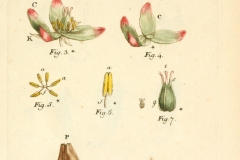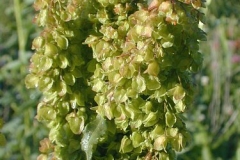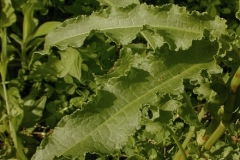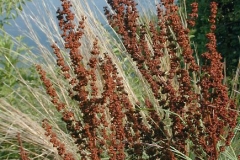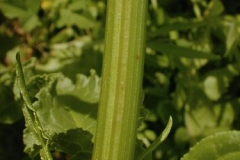Health Benefits of Dock vegetable
- Constipation relief
The herb contains glycocides and anthraquinones which makes it a potent laxative. It soothes inflamed intestinal linings and also stimulates free bowel movement to support constipation and indigestion. It stimulates production of stomach acids and enzymes. Take this tea three times a day.
- Enhance digestion
Dock helps to solve stomach issues. It assists in treating indigestion or heartburn by counterbalancing stomach acid. It promotes digestion by stimulating release of stomach acid as well as digestive enzymes. Intake yellow dock in form of tea three times a day before meal to promote digestive health.
- Skin health
Apply the ointment made from this herb to abrasions, skin lesions, sores and eruptions. Native Americans use powdered pulp of herb and apply to various skin ailments.
- Acts as antioxidant
Scientific study shows that root has antioxidants which neutralize free radicals preventing tissue as well as cell damage especially in the liver. Such benefit could be experienced with an intake of tea made of herb’s extracts.
- Helpful for anemia
Root of yellow dock helps to improve iron absorption in intestines. Moreover, iron assist in red blood cells production and combat anemia. It contains holistic chemicals known as bio-flavonoids which strengthen capillaries and assist blood circulation. It is also helpful for constipation and skin problems.
- Laxative activity
Yellow dock enhances digestion as it acts as a natural laxative. It contains small amount of anthraquinone glycosides which supports release of water in intestines and promotes release of bowels. When used in form of tea, it provides a relief from constipation.
Culinary uses
- Leaves are cooked as well as consumed raw.
- Add leaves to salads, soups or cook as potherb.
- Roasted seeds are used as a substitute for coffee.
Medicinal uses
- It is used to treat mild constipation and various skin problems.
- It provides relief from diarrhea.
- It is used to treat diarrhea, constipation, bleeding of lungs and piles.
- Poultice made from roots are used to treat ulcers, sores, wounds and skin problems.
- When used excessively, it could cause nausea, gastric disturbance and dermatitis.
- It is used to treat cough.
Side effects
- Plants have high oxalic acid levels.
- Cooking helps to lower oxalic acid content.
- It might worsen the condition of arthritis, rheumatism, hyperacidity or kidney stones.
- People using drugs such as diuretics, miacalcin, Dilantin and mithracin should not use dock.
- Avoid its use by people with liver disease, kidney disease and electrolyte abnormality.
- Consult the health practitioner if experienced seizures, fatigue, numbness around mouth and muscle spasms.
References:
https://www.itis.gov/servlet/SingleRpt/SingleRpt?search_topic=TSN&search_value=20937#null
http://www.hear.org/pier/species/rumex_crispus.htm
https://pfaf.org/user/plant.aspx?LatinName=Rumex+crispus
https://en.wikipedia.org/wiki/Rumex_crispus
https://www.illinoiswildflowers.info/weeds/plants/curly_dock.htm
https://plants.usda.gov/core/profile?symbol=RUCR
http://www.iucngisd.org/gisd/species.php?sc=1652
http://tropical.theferns.info/viewtropical.php?id=Rumex+crispus
https://www.verywellhealth.com/the-benefits-of-yellow-dock-89534
https://healthyfocus.org/benefits-of-yellow-dock/
https://urbol.com/yellow-dock-root/
Comments
| Dock vegetable Quick Facts | |
|---|---|
| Name: | Dock vegetable |
| Scientific Name: | Rumex crispus |
| Origin | Europe and Western Asia |
| Colors | Brown |
| Shapes | Achene, 3.5-6 x 3-6 mm |
| Calories | 29 Kcal./cup |
| Major nutrients | Vitamin C (70.89%) Iron (39.88%) Vitamin A (38.00%) Magnesium (32.62%) Tryptophan (28.41%) |
| Name | Dock vegetable |
|---|---|
| Scientific Name | Rumex crispus |
| Native | Europe and Western Asia |
| Name in Other Languages | German: Krauser Ampfer; Danish: Kruset skræppe; English: Curled dock, Curly dock, Narrowleaf dock, Sour dock, Yellow doc, Indian tobacco, Curly-leaved dock, Narrow-leaved dock; Norwegian: Berghøymol; Swedish: Lippskräppa; Chinese: zhou ye suan mo; French: herbe patience, oseille crépu, oseille, patience, reguette, patience crépu, rumex crépu; Japanese: nagaba-gishi-gishi; Spanish: acedera crespa, lengua de caballo, acelgas, gualtata, lengua de vaca, romaza crespa, romaza, vinagrillo; Afrikaans: krultongblaar, weeblaar; French: patience crépu, reguette, rumex crêpu; German: krauser Ampfer; Italian: romice conglomerate; Portuguese: labaça-crespa, labaça-selvagem, língua-de-vaca, paciência; Swedish: krusskräppa |
| Plant Growth Habit | Herbaceous perennial |
| Plant Size | 1 to 3 feet tall |
| Stem | 30-160 cm |
| Leaf | Oblong-lanceolate; 6 inches long and 1 inches across |
| Flowering Season | June – September |
| Fruit shape & size | Achene, 3.5-6 x 3-6 mm |
| Seeds | Winged |
| Seed weight | 1 to 3 g |
| Flavor | Slightly sour |
| Major Nutritions | Vitamin C (Ascorbic acid) 63.8 mg (70.89%) Iron, Fe 3.19 mg (39.88%) Vitamin A, RAE 266 µg (38.00%) Magnesium, Mg 137 mg (32.62%) Tryptophan 0.125 g (28.41%) Manganese, Mn 0.464 mg (20.17%) Copper, Cu 0.174 mg (19.33%) Isoleucine 0.222 g (13.28%) Vitamin B6 (Pyridoxine) 0.162 mg (12.46%) Phosphorus, P 84 mg (12.00%) |
| Calories in 1 cup, chopped (133 g) | 29 Kcal. |



